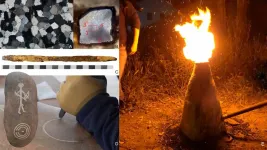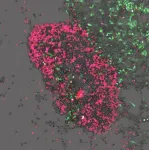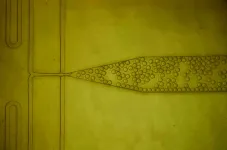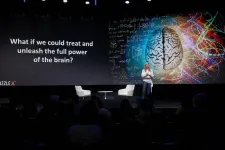(Press-News.org) A study by an international and interdisciplinary team headed by Freiburg archaeologist Dr. Ralph Araque Gonzalez from the Faculty of Humanities has proven that steel tools were already in use in Europe around 2900 years ago. Using geochemicalanalyses, the researchers were able to prove that stone stelae on the Iberian peninsula that date back to the Final Bronze Age feature complex engravings that could only have been done using tempered steel. This was backed up by metallographic analyses of an iron chisel from the same period and region (Rocha do Vigio, Portugal, ca. 900 BCE) that showed the necessary carbon content to be proper steel. The result was also confirmed experimentally by undertaking trials with chisels made of various materials: only the chisel made of tempered steel was suitably capable of engraving the stone. Until recently it was assumed that it was not possible to produce suitable quality steel in the Early Iron Age and certainly not in the Final Bronze Age, and that it only came to be widespread in Europe under the Roman Empire. “The chisel from Rocha do Vigio and the context where it was found show that iron metallurgy including the production and tempering of steel were probably indigenous developments of decentralized small communities in Iberia, and not due to the influence of later colonization processes. This also has consequences for the archaeological assessment of iron metallurgy and quartzite sculptures in other regions of the world,” explains Araque Gonzalez. The study ‘Stone-working and the earliest steel in Iberia: Scientific analyses and experimental replications of final bronze age stelae and tools’ has been published in the Journal of Archaeological Science.
Iberian pillars of siliceous quartz sandstone could only be worked with tempered steel
The archaeological record of Late Bronze Age Iberia (c. 1300-800 BCE) is fragmentary in many parts of the Iberian Peninsula: sparse remains of settlement and nearly no detectable burials are complemented by traces of metal hoarding and remains of mining activities. Taking this into account, the western Iberian stelae with their depictions of anthropomorphic figures, animals and selected objects are of unique importance for the investigation of this era.
Until now, studies of the actual rocks from which these stelae were made to gain insights into the use of materials and tools have been the exception. Araque Gonzalez and his colleagues analyzed the geological composition of the stelae in depth. This led them to discover that a significant number of stelae was not as had been assumed made of quartzite, but silicate quartz sandstone. “Just like quartzite, this is an extremely hard rock that cannot be worked with bronze or stone tools, but only with tempered steel,” says Araque Gonzalez.
Chisel discovery and archaeological experiment confirm use of steel
Analysis of an iron chisel found in Rocha do Vigio showed that Iberian stonemasons from the Final Bronze Age had the necessary tools. The researchers discovered that it consisted of heterogeneous yet astonishingly carbon-rich steel. To confirm their findings, the researchers also carried out an experiment involving a professional stonemason, a blacksmith and a bronze caster, and attempted to work the rock that the pillars were made of using chisels of different materials. The stonemason could not work the stone with either the stone or the bronze chisels, or even using an iron chisel with an untempered point. “The people of the Final Bronze Age in Iberia were capable of tempering steel. Otherwise they would not have been able to work the pillars,” concludes Araque Gonzalez as a result of the experiment.
Project website with further information and videos: https://www.experimentalarchaeology.uni-freiburg.de/
Summary:
Original publication: Araque Gonzalez, A., Asmus, B., Baptista, P., Mataloto, R., Díaz Paniego, P., Rammelkammer, V., Richter, Alexander, A., Vintrici, G., Mählmann Ferreiro, R. (2023): Stone-working and the earliest steel in Iberia: Scientific analyses and experimental replications of final bronze age stelae and tools. In: Journal of Archaeological Science (152): 105742. https://doi.org/10.1016/j.jas.2023.105742
Dr. Ralph Araque Gonzalez is the leader of the DFG project Die Iberischen Stelen der Spätbronzezeit: Bildkunst, Technologie und Wissenstransfer zwischen Atlantik und Mittelmeer at the Institute of Archaeology (IAW) of the University of Freiburg.
The study was funded by the German Research Foundation (DFG project no. AR 1305/2-1)
Contact:
Annette Kollefrath-Persch
University and Science Communications
University of Freiburg
Tel.: 0761/203-8909
Email: annette.persch@pr.uni-freiburg.de
END
Steel was already used in Europe 2900 years ago
2023-02-28
ELSE PRESS RELEASES FROM THIS DATE:
Better metric for prioritizing conservation of “evolutionarily distinctive” species
2023-02-28
An updated metric for prioritizing species’ conservation that incorporates scientific uncertainty and complementarity between species, in addition to extinction risk and evolutionary distinctiveness, is publishing February 28th in the open access journal PLOS Biology, authored by Rikki Gumbs from the Zoological Society of London (ZSL), UK, and colleagues.
In 2007, ZSL established the Evolutionarily Distinct and Globally Endangered (EDGE) metric to prioritise species for conservation based on preserving evolutionary history embodied within endangered species. The approach ...
Parental investment may have aided evolution of larger brains
2023-02-28
A review of evidence from prior research provides new support for the possibility that the evolution of larger brains in some species was enabled through increased energy investment by parents in their offspring. Carel van Schaik of the Max Planck Institute for Animal Behavior in Konstanz, Germany, and colleagues present their arguments in a paper publishing February 28th in the open access journal PLOS Biology.
Between different species, larger relative brain size is associated with cognitive benefits that favor survival. However, larger brains ...
Profiling abortions in low- and middle-income countries
2023-02-28
Multiple factors including a women’s age, marriage status, education and how many living children she has, are associated with pregnancy termination in low- and middle-income countries, according to a new study published this week in the open-access journal PLOS Global Public Health by Djibril Ba of Penn State College of Medicine, US, and colleagues.
In low- and middle-income countries (LMICs), a woman’s decision to terminate a pregnancy is often impacted by a patriarchal structure of society, restrictive abortion laws, cultural and religious beliefs and economic factors. About 45% ...
Hollings researchers develop small molecule to stimulate natural killer cells against neuroblastoma
2023-02-28
An MUSC Hollings Cancer Center research team has created what team members believe to be among the first small molecules designed to stimulate immune cells to fight cancer. More importantly, these compounds inhibit a specific enzyme that hasn’t been targeted with small molecules for the treatment of cancer.
Small molecules are, quite literally, small. They’re hundreds of times smaller than monoclonal antibodies currently used in therapy, and they’re also structurally much simpler. Because of their low molecular mass, they are much more likely to enter cells. Aspirin, for example, is a small molecule ...
'Informal carers’ experienced mental health decline ‘akin to divorce’ during COVID lockdowns
2023-02-28
People who became carers during Covid-19 by helping family members, friends or neighbours in need experienced a sharp decline in their own mental health, new research from Lancaster University reveals.
Using the General Health Questionnaire (GHQ) scale – a psychometrically validated and widely used index of psychological distress – researchers studied individual responses to the UK Household Longitudinal Study (Understanding Society).
They looked at 4698 participants from a total of 11 surveys - three before COVID-19 and eight collected between April 2020 ...
CU School of Medicine researchers part of national team that identified a new dietary approach to treatment for eosinophilic esophagitis
2023-02-28
Research by a team that includes two faculty members from the University of Colorado School of Medicine may change the treatment paradigm for patients with eosinophilic esophagitis (EoE), an allergic condition that causes chronic inflammation in the esophagus that can lead to esophageal narrowing and dysfunction.
Glenn Furuta, MD, professor of pediatric gastroenterology, hepatology, and nutrition, and Paul Menard-Katcher, MD, associate professor of gastroenterology, helped lead the National Institutes of Health (NIH)-funded, multisite study that shows that a single-food ...
New purification method could make protein drugs cheaper
2023-02-28
CAMBRIDGE, MA -- One of the most expensive steps in manufacturing protein drugs such as antibodies or insulin is the purification step: isolating the protein from the bioreactor used to produce it. This step can account for up to half of the total cost of manufacturing a protein.
In an effort to help reduce those costs, MIT engineers have devised a new way to perform this kind of purification. Their approach, which uses specialized nanoparticles to rapidly crystallize proteins, could help to make protein drugs more affordable and accessible, especially in developing ...
Graphene Flagship spin-off company INBRAIN Neuroelectronics wins prestigious innovation award
2023-02-28
INBRAIN Neuroelectronics, a Graphene Flagship spin-off company, has been named Spain’s most innovative company by leading Spanish news publication El Periódico.
INBRAIN exists to decode and modulate neural networks to improve patients’ lives. More specifically, INBRAIN is harnessing the unique properties of graphene to develop high density and high-resolution brain interfaces coupled to an intelligent system with high signal processing power to provide breakthrough neuroelectronic therapies.
The company was founded in 2020 by researchers from Graphene Flagship partner the Catalan Institute of Nanoscience ...
Henry Ford Medical Group appoints Dr. Brien J. Smith to top neurology role
2023-02-28
DETROIT (February 28, 2023) – The Henry Ford Medical Group today announced Brien J. Smith, M.D., MBA, a national expert in neurology and epilepsy, as its new Chair of the Department of Neurology.
In this leadership role, Dr. Smith will oversee all clinical, research and administrative services for the Department of Neurology at Henry Ford Health. A veteran of Henry Ford, Dr. Smith was previously part of Henry Ford Hospital’s Neurology Department for 18 years, serving as Director of the Epilepsy Monitoring Unit, Medical Director of the Comprehensive Epilepsy Program, and Director of the Clinical Neurophysiology Program at Henry Ford Hospital in Detroit. He ...
Responsive ankle exoskeleton algorithm handles changes in pace and gait
2023-02-28
Images
Ankle exoskeletons that can help people extend their endurance are a step closer to reality with a new control algorithm, developed at the University of Michigan, that could enable future exoskeletons to automatically adapt to individual users and tasks. This would reduce or eliminate the need for manual recalibration.
Current exoskeletons are limited because they must be tailored to a single user performing a single task, like walking in a straight line. Any changes require a lengthy set ...







